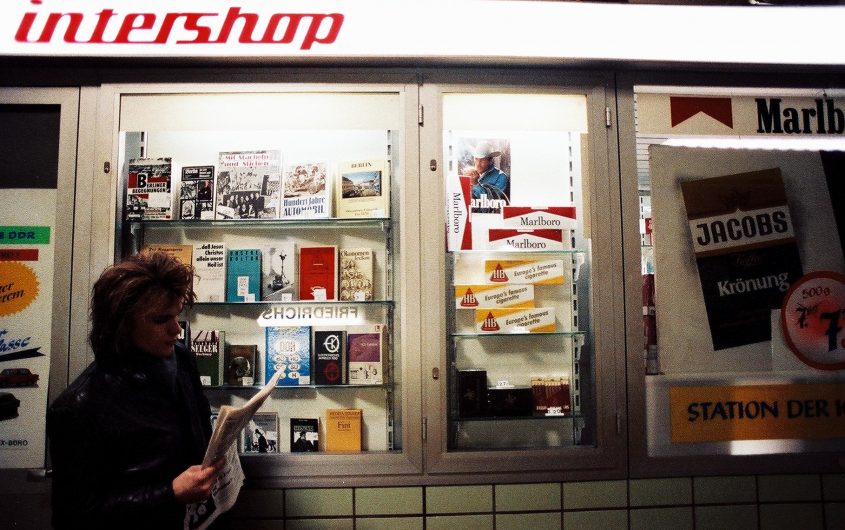
The Decaffeinated Crisis

Steven Ewin
Finance and Development Associate
Steven Ewin is the Finance and Development Associate at AICGS. Prior to joining AICGS, Mr. Ewin worked in a variety of sales and financial positions throughout the public and private sectors. He spent eight years in the United States Army, where he was stationed throughout the world.
He holds a BA in History from Southern New Hampshire University, where his course of study focused on state sovereignty in Cold War Europe. He has completed graduate coursework in Data Analytics and International Relations.
__
East Germany and Social Unrest in 1977
As the current supply chain issues continue, it is worth examining how similar disruptions have historically caused social unrest. Despite scarcity, the German Democratic Republic (GDR) attempted to grow a culture surrounding coffee, tying it to the virtues of socialism. When a worldwide coffee supply disruption affected the already weak coffee supply of East Germany, ineffective state leadership resulted in heavy social unrest, culminating in strikes. The 1977 East German coffee shortage showcased not just the fragility of the East German economy, but also the fragile trust between population and government.
East Germany did not have access to the same level of luxury goods as the West. Immediately after the Second World War and through the 1950s, the Soviet Union supplied most of the coffee in the German Democratic Republic. Beginning in the 1950s, the GDR started to rely less on the Soviet Union for their imports, brokering their own trade deals. Simultaneously, the need to import greater and greater amounts of coffee sharply increased. By the 1970s, the average East German coffee household expenditure was twice the amount spent on shoes and equal to the amount spent on furniture. Coffee accounted for 4 percent of all retail sales in the GDR.
As the East German state attempted to gain coffee independence, the coffee itself became a core part of GDR identity. According to historian Stefan Wolle in Die heile Welt der Diktatur, the coffee culture of the GDR provided an essential source of identity for the average worker. Outside of the workplace, conversation over coffee provided a welcome respite and sharing of personal expression in the tightly monitored East German state. Andrew Kloiber’s research shows the Socialist Unity Party (Sozialistische Einheitspartei Deutschlands, SED), positioning coffee and its culture as key to the Socialist identity. Coffee allowed workers to be more productive, which contributed to a more prosperous society while maintaining an aesthetic of an invigorated society. Further, it gave the SED legitimacy by being able to provide such a scarce resource.
The black market posed a continuous challenge to this assertion. While the SED had hoped to offer luxury coffee through official stores, the East German populace depended on families in West Germany sending coffee as a gift through the Iron Curtain. This Faustian bargain wasn’t accepted by the SED leadership, who were continually dealing with a black market driven by a quest for a better bean. Attempts to curb this market, such as setting up a mail order system for those in the West to buy beans for the East, largely failed.
Two events at the beginning of the 1970s shook the East German economy to its core: the 1973 oil shock and a failed coffee crop in Brazil. These events reverberated through the world at large, affecting the Western currency that propped up the GDR’s economy. It was impossible for the GDR to import oil without using money it had acquired from the West. As the price of oil skyrocketed, so did the rate at which the GDR drained its reserves of Western currency. Luxury imports, purchased with western currency, became prohibitively expensive. Before the failed coffee crop, the GDR spent 150 million marks per year on coffee imports. After the crisis began, this number skyrocketed to 700 million. The SED faced a dilemma: money for oil, or marks for mocha?
The SED attempted to split the difference. Internal controls and goals shifted to accommodate the higher costs of imports. The only coffee imported would be the higher-end blends that the party leadership used. Lower-end brands were either eliminated or the recipe adjusted to use less coffee. Further, certain blends would only be available in Intershops, which required the use of Western currency. While the SED did not expect the new coffee mixes to be popular, they did expect that their citizens would be willing to place the needs of the collective socialist state above their own.
East Germans rejected the new coffee mixes. By the fall of 1977, this rejection had reached a critical point. In a report to SED leadership on September 1, 1977, the Ministry for State Security (Ministerium für Staatssicherheit, MfS, commonly known as the Stasi) stated that, “the quality and price of [the new coffee mixes] are rejected by broad circles of the population.”
Complaints recorded by the MfS included “critical indications of taste,” and a first indication that the new mixes were unable to be processed to the “full filtering capability in household machines.” The MfS reports stated deeper frustrations. Only those with access to Intershops could still buy coffee, while the new austerity only affected the “little man.” Workers resented party officials requesting austerity for workers while still importing “expensive Western cars for officials.” Additionally, workers did not believe the “information policy” was satisfactory. Far from just rejecting the new coffee mixes out of hand, the MfS reports indicate that the East German populace was rejecting the SED’s handling of the crisis in general.
By September 12, the frustration over austerity moved to unrest. An MfS report stated that in discussions among workers, “skeptical, resigned, pessimistic and negative opinions up to aggressive arguments become clear.” While blaming Western media for this development, the MfS warned about rumors of strikes. These strikes would demand wages be paid in Western currency so that workers would be able to shop at the Intershops. Further, the report states growing frustration with the expansion of Intershop stores, with the simultaneous “elimination of low-price coffees and the limited supply in restaurants.”
Workers also believed that the GDR was now fully stratified. Workers identified three social categories: those without western currency who would be forced to endure austerity, those with access to western currency who could shop at Intershops, and “privileged persons and high officials who…drove expensive Western cars and [weren’t] affected by austerity.” These last two categories were contrasted with the common worker and pensioner who “have returned to the point where begging letters have been sent to [West Germany]” for coffee.
These reports would continue the following week. Containing many of the same warnings as the previous report on dissatisfaction, a new development was added: criticism of SED party officials. The MfS reported, “derogatory terms for the ‘coffee mix’ are circulating,” and that “leading officials are vilified.” Further, workers now believed that “warning strikes” had started to take place throughout the country.
The SED would finally act on September 23 to contain the growing unrest. First, the government reduced the price of the lowest quality mixes. Second, the Ministry of Trade and Supply published a communication about the coffee shortage and the reasoning behind austerity measures. As noted in the MfS report on the situation, the public accepted the reasoning while noting they should have been told sooner. While the MfS expressed optimism that the crisis and information could now be contained, the unrest continued to simmer. Reports of strikes would continue into October, and workers continued to ask for wages to be paid in Western currency.
Shaken by how quickly the public had moved to unrest from a supply chain disruption, the SED sought to strengthen the supply chain. East Germany would effectively bootstrap Vietnam’s coffee industry, providing materials and training in exchange for a secured supply chain. Vietnam would thrive as the second largest coffee exporter in the world (accounting for 22 percent of all German coffee imports in 2020). The coffee improved, and East German brands are still popular—including in west Germany. Yet the damage done to the trust between the East German people and the SED continued to reverberate and never fully be repaired. East Germany would cease to exist on October 3, 1990.







